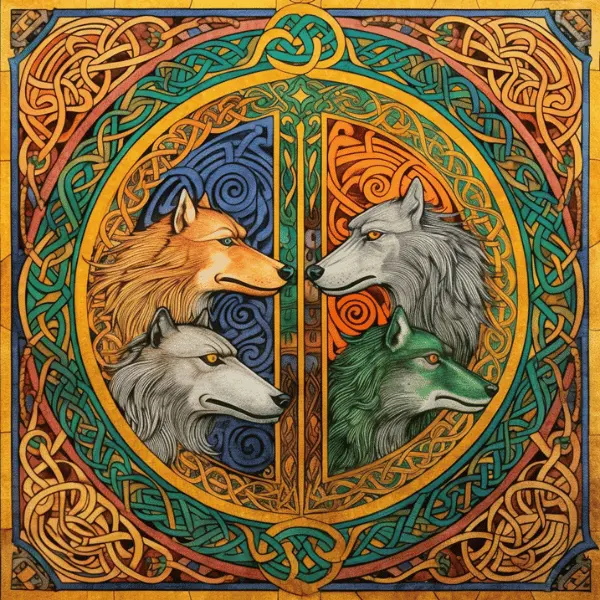Celtic mythology, originating from the ancient Celtic people spread across Western Europe, particularly Ireland and Scotland, has formed a rich tapestry of legends, folklore, and religious beliefs. It is known for its complex structure, imbued with symbolism, where nature and animals are key to understanding Celtic spirituality and the cosmos. Gods, goddesses, heroes, and villains all feature in a range of stories that have been handed down through generations, often orally, which impart moral guidance, historical narratives, and explanations for the mysteries of life and death. Now, let’s find out about wolves in Celtic mythology.
The Wolf In Celtic Mythology
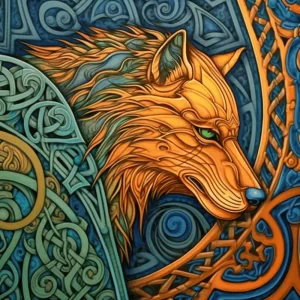
Importance of Animals in Celtic Mythology
Animals held a significant place in Celtic mythology, acting as emblems of deities, symbols of virtues, omens of forthcoming events, or even metaphysical representations of the natural world. Different animals were associated with varying traits and abilities; the strength of a bull, the wisdom of a salmon, or the courage of a boar, or the cunning of a fox for example. To read more about the use of foxes in Celtic mythology, click here.
The animal kingdom was seen as intimately connected with the human realm, informing everyday life, rituals, and celebrations, thus playing a vital role in the cultural, spiritual, and symbolic landscapes of the Celts.
Wolves in Celtic Mythology – A Symbol
Among the vast array of animals featuring in Celtic mythology, the wolf holds a unique position. Initially, wolves were likely observed by the Celts with a blend of admiration and fear due to their hunting prowess, pack mentality, and resonant howls that echoed through the forests. Over time, these real-world characteristics formed the basis for the wolf’s symbolic role in Celtic mythology. The wolf came to be associated with strength, endurance, and sharp intelligence. It was perceived as both a guide and a guardian in the spiritual realm, leading souls through transitions and protecting sacred spaces. This early introduction of the wolf set the stage for its deeper incorporation into Celtic culture and mythology, leading to more specific roles and narratives that will be further explored in subsequent sections of this discussion.
The Wolf in Celtic Culture
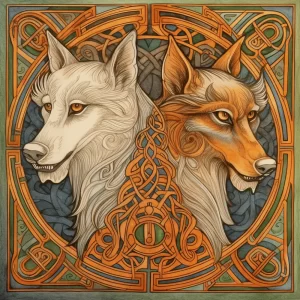
The Role of the Wolf in Ancient Celtic Society
In ancient Celtic society, the wolf held an essential role that crossed the boundary of the physical and spiritual realms. As a social animal with potent hunting skills, the wolf was both revered and respected. It was seen as a symbol of endurance and fierce intelligence, and its significant presence in Celtic lore and art is a testament to its status. In day-to-day life, the howl of a wolf in the distance could signal danger, and wolves’ tracks would be used to forecast the weather. They were also an integral part of the mythological narratives, symbolising different aspects of life, death, and transformation.
Celtic Hunting Practices and Warfare
In terms of hunting practices, the Celts observed wolves’ strategies and behaviour, gaining insights that were applicable to their own hunts. The communal hunting methods of the wolf pack demonstrated the effectiveness of teamwork and strategy in bringing down larger prey, lessons the Celts adapted to their advantage. Moreover, the stealth and resilience displayed by wolves in the hunt became an aspirational model for Celtic hunters.
Wolves’ role in warfare was both literal and symbolic. Celtic warriors would adorn their shields, helmets, and banners with wolf symbols to embody the animal’s ferocity and bravery. In battle, the war cries of the Celts were often likened to the haunting howl of the wolf, designed to intimidate enemies and bolster the morale of the warriors. Legends tell of warriors invoking the spirit of the wolf for strength and courage in battle. Overall, wolves’ relevance in Celtic hunting practices and warfare reflects the profound respect and recognition the Celts had for this formidable creature’s capabilities.
Symbolism of the Wolf
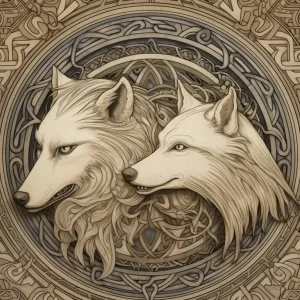
Symbolic Meaning of the Wolf in Celtic Mythology
In Celtic mythology, the wolf was regarded as a powerful symbol with profound spiritual significance. As an apex predator, it symbolised strength, endurance, and intelligence. However, beyond its physical attributes, the wolf carried deeper metaphysical associations. Given its social nature and familial structures, it was seen as an emblem of kinship, loyalty, and community.
The wolf was also revered as a guide to the spirit realm. The Celts believed that wolves could escort the souls of the deceased to the afterlife. This belief stemmed from the animal’s nocturnal activities and its haunting howl, often associated with communication with the spirit world.
Lastly, the wolf was recognised as a symbol of transformation. Its dual existence between the physical and spiritual realms, along with its capability to adapt in harsh environments, underscored the idea of change, growth, and survival, fundamental themes in Celtic mythology.
Dual Nature of the Wolf Symbol (e.g. Fear and Respect)
The wolf symbol in Celtic mythology held a dual nature, evoking both fear and respect. On the one hand, its status as a top predator, combined with its haunting nocturnal presence, elicited fear. Stories of wolves hunting in packs and their echoing howls during cold nights painted a picture of a formidable beast, warranting caution.
On the other hand, the Celts deeply respected the wolf for its resilience, strength, and communal bonds. They saw in the wolf a mirror to their own survival in challenging conditions, appreciating the animal’s efficient hunting strategies, adaptability, and strong pack mentality. The dual perception of fear and respect for the wolf encapsulates the Celts’ deep understanding and reverence for the intricacies of the natural world, wherein danger and admiration can exist side by side.
Wolves in Celtic Folklore and Legends

Celtic Tales and Legends That Feature Wolves
Wolves feature prominently in many Celtic tales and legends. In Scotland, the tale of the Macleod family is noteworthy, where a chieftain received assistance from a white fairy wolf. The wolf, who was a transformed fairy, guided him out of danger during a fierce battle, symbolising guidance and protection.
In another story, “The Táin Bó Cúailnge” (The Cattle Raid of Cooley), the great hero Cúchulainn was assisted by wolves under the command of the war goddess Morrigan. The wolves were portrayed as allies, demonstrating loyalty and bravery, essential traits valued by the Celts.
The Famous ‘Faoladh’ or ‘Conriocht’, the Werewolves in Irish Folklore
The ‘Faoladh‘ or ‘Conriocht’ is a central character in Irish folklore, translating as ‘wolf-man’ or ‘werewolf’. Unlike contemporary werewolf legends, the Faoladh was considered benign, often acting as a protector of children and the wounded. Stories describe the Faoladh guiding lost people to safety or protecting villages from threats. These werewolves were believed to be individuals under a spell or chosen by the divine to live as wolves for seven years, emphasizing the mystical connection between humans and wolves in Celtic mythology.
The Tale of Morrigu, the Celtic Goddess Who Could Shape-shift into a Wolf
Morrigu, also known as Morrigan, is a tripartite Celtic goddess associated with war, fate, and sovereignty. In the mythological narrative, Morrigu has the ability to shape-shift into various animals, one of which is a wolf. She used this ability during battles, using fear as a weapon against her enemies. Her transformation into a wolf symbolized strength, strategic prowess, and the encompassing power of transformation.
In the epic tale of “The Táin Bó Cúailnge”, Morrigu aids the hero Cúchulainn by transforming into a wolf and a heifer, leading a herd to stampede through enemy lines, demonstrating her strategic use of the wolf form. The tales of Morrigu underscore the versatile symbolic role of the wolf in Celtic mythology, bridging the physical and divine realms.
Wolves and Celtic Deities
Celtic Deities Associated with Wolves
In Celtic mythology, several deities exhibit a connection to wolves, signifying the animal’s importance within their cosmology. Notably, Morrigu, the tripartite goddess, embodies the war, death, and transformation aspects often associated with wolves. Her ability to shape-shift into a wolf portrays the creature’s power and ferocity.
Similarly, the Irish mythological figure Lugh, the sun god, is also linked to wolves. As a master of all arts, Lugh’s association with wolves underscores the animal’s symbolic complexity, embodying traits such as intelligence, leadership, and versatility.
The Legend of Cerrunnos, the Horned God Often Depicted with Wolf Companions
Cernunnos, the horned god of Celtic mythology, is often depicted with companions from the animal kingdom, among them the wolf. He represents the masculine elements of nature, fertility, life, and the animal realm.
The presence of wolf companions in his iconography symbolizes strength, intuition, and an untamed spirit. Just as Cernunnos himself embodies the untamed and wild aspects of nature, his wolf companions reflect the same characteristics. They signify the essence of wild, free nature, further associating Cernunnos with the values of freedom, instinct, and natural harmony.
Relationship Between the Goddesses Morrigan and Badhbh, and the Wolf
The Morrigan, a goddess associated with war and fate, has been previously discussed for her ability to transform into a wolf. However, another layer of her connection with wolves stems from her association with the goddess Badhbh. Badhbh is one of the three aspects of the Morrigan and is often depicted as a crow or raven, but her connection to the battlefield and death links her indirectly to wolves.
In Celtic battlefields, scavengers, particularly wolves and crows, were a common sight. As a result, both animals became associated with death, war, and the transition to the afterlife. Thus, while Badhbh is more closely linked to the crow, her association with death and war extends the connection to wolves, further intertwining the Morrigan with these fierce creatures. These links show the intricate and multi-layered relationship the Celtic deities had with the wolf, enhancing our understanding of their mythology.
The Wolf as a Totem in Celtic Culture
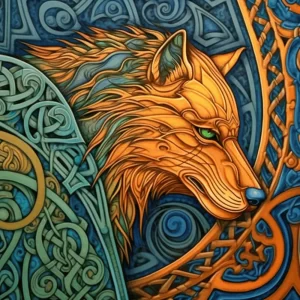
The Concept of Animal Totems in Celtic Spirituality
The Celts held a deep reverence for the natural world and saw divinity in its every aspect. Animals played an integral part in this spiritual understanding. Specific animals, known as totems, were believed to embody particular qualities and spiritual energies that clans, families, or individuals could learn from and align with. Totem animals were seen as guides, protectors, and helpers on both physical and spiritual journeys. The wolf, with its powerful symbolism, held a prominent place as a totem in Celtic culture.
Characteristics and Qualities the Celts Associated with the Wolf Totem
In Celtic belief, the wolf was a symbol of profound transformation and personal growth, respected for its cunning, intelligence, and fierce independence. As a totem, the wolf offered the promise of protection, as well as guidance in navigating the unseen realms of intuition and instinct.
The wolf’s loyalty to its pack echoed the Celtic value of kinship and community. Their cooperative hunting strategies and nurturing of their young resonated with the Celts’ emphasis on teamwork and the importance of family ties.
The courage of the wolf was also revered. As a creature living on the edges of civilization, often facing harsh conditions and challenges, the wolf represented resilience and the capacity to confront and overcome fears. It symbolized the spirit of endurance and survival, embodying the heart of a warrior, a quality deeply admired by the Celts.
Wolf’s Influence on Celtic Rituals and Traditions
The wolf’s influence pervaded Celtic rituals and traditions. During Samhain, a festival marking the end of the harvest season and the onset of winter, it was believed that the barriers between the human world and the spirit world thinned. In this spectral atmosphere, the wolf’s symbolic association with transformation, intuition, and the spirit world came to the forefront.
As a totem, the wolf would often be invoked for guidance and protection during these otherworldly encounters. Its energies were called upon to provide courage and resilience in facing the dark and unknown, just as the wolf braves the wilderness’s harsh uncertainties.
Additionally, in initiation rituals, the totemic wolf energy might be invoked to signify a personal transformation or rite of passage. It was seen as an embodiment of the qualities the initiates needed to integrate into their personal character.
Moreover, symbols and depictions of wolves featured prominently in Celtic art and jewelry, often worn as amulets or talismans, which served as physical reminders of the wolf’s energy and the spiritual lessons it bore.
The Decline and Re-emergence of Wolf Symbolism
The Decline of Wolves in the Celtic Lands and its Impact on Folklore and Culture
The once-abundant wolf population in Celtic lands began to decline from the Middle Ages onwards, largely due to deforestation and active persecution. As human settlements expanded, wolves were seen less as revered symbols and more as threats to livestock and human safety. Their status shifted from sacred togetherness to feared beasts, resulting in widespread hunting.
This physical decline had significant implications for Celtic culture and folklore. With wolves no longer a part of everyday life, their place in stories and rituals began to diminish. Wolves became more of historical and symbolic references, rather than contemporary fixtures. Their reputation as feared beasts lingered, casting a shadow over their previously venerated status.
Nonetheless, even as the wolves disappeared, their symbolic power in Celtic mythology endured. They became ghostly figures, more present in tales and legends than in reality, their strength and resilience living on in the stories passed down through generations.
The Re-emergence of Wolf Symbolism in Contemporary Celtic Culture and Neo-pagan Practices
In recent times, there has been a resurgence of interest in ancient Celtic traditions and mythology, part of a broader neo-pagan movement that seeks to revive and honor pre-Christian spiritual practices. This revival has brought with it a renewed interest in the wolf as a symbol of strength, family, and transformation.
Modern reinterpretations of Celtic mythology often emphasize the nobility and wisdom of the wolf, focusing on their protective, loyal nature and their association with divine entities. In neo-pagan practices, the wolf has returned as a powerful totem animal, invoked for guidance and protection during rituals and meditations. Its symbolism of transformation is particularly resonant in personal spiritual journeys, offering lessons of resilience, courage, and self-reliance.
Moreover, the re-emergence of wolf symbolism has implications beyond spiritual practices. It is becoming a part of contemporary Celtic culture, featuring prominently in art, literature, and music. Its image has become a symbol of the wild spirit of the Celtic lands, representing a longing for a connection with the untamed natural world.
The re-emergence of the wolf in Celtic culture highlights a broader shift towards a more harmonious relationship with nature, underlining the need for environmental stewardship and respect for all creatures. As we move forward, the wolf stands as a reminder of our shared history with the natural world, a symbol of a past when humans and animals lived in closer harmony, and an inspiration for a future where such a balance might be regained.

